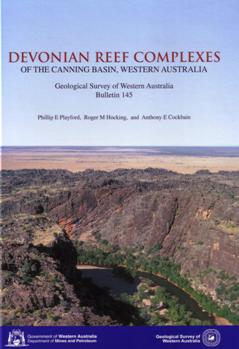Devonian Reef Complexes of the Canning Basin, Western Australia
Geological Survey of Western Australia Bulletin No.145
Phillip E Playford, Roger M Hocking & Anthony E Cockbain
Published by: GSWA
Publication date: August 2009
ISBN: 978-1-74168-233
List price: $AUS 77.00, plus postage
444 pp
www.dmp.wa.gov.au

This Bulletin is a remarkable testament to the work of the geologists of the Geological Survey of Western Australia in their studies of the Devonian rocks of the Canning Basin in the southern Kimberley. The senior author of this book, Phil Playford, has been mapping, logging and researching the area for more than 50 years. Co-authors Roger Hocking and Anthony Cockbain have also spent many field seasons there. The Bulletin summarises the Survey’s recent work, its numerous publications, along with the results of studies by others from the GSWA, and students and staff of universities in Australia and elsewhere. It is a spectacular book that provides a fitting tribute to one of the most famous and best exposed reef complexes in the world.
After a fascinating introduction explaining the history of the discovery of the area, and notes on the natural history and human occupation, around 100 pages deal with the facies, lithostratigraphy and sequence stratigraphy, as well as the role of tectonics in platform development, the diagenesis and burial. The next section deals with the conglomerates, an interesting story one rarely hears about – of coarse clastics being supplied from the nearby Precambrian Kimberley block, deposited in alluvial fans-fan deltas, and interfingering with peritidal carbonates. Of note is their interpretation as highstand facies, rather than lowstand as one might have thought, and linked to active regional tectonism.
The section on metre-scale cyclicity in the Pillara Limestone will be of wide interest since we are still trying to fathom out the causes of such cycles. The ones here are quite typical for the Devonian, many shallowing-upward and subtidal dominated, others peritidal with tidal-flat facies. However, in view of the close source of the clastics, many are mixed, with shallow-subtidal, often stromatoporoid-rich limestones, passing up into terrigenous deposits of shoreline, mud flat and fluvial facies. The cycle duration in the Pillara Limestone is in the range of 12-20 kyr, and cycles are bundled into ‘megacycles’ (parasequence-sets), always a good argument for orbital forcing. However, local tectonic influences were also significant.
There are both epi- and syn- genetic mineral deposits within the limestones, and Pb-Zn deposits of the MVT-type have been worked in the past. Of particular interest are the exhalative mineral deposits, notably barite, and the associated microbial precipitations – amazing stuff – a great story of cool-water venting on the seafloor, thriving bacteria and mineral precipitation. The barite is intriguing – forming ‘shrubs’ of fibrous crystals and plumose structures, and closely associated with stromatolites, mostly composed of radiating fibrous calcite.
For me the most remarkable aspect of the Canning Basin is the role of the Permian glaciation, which created much of the landscape we see today. The famous gorges of Windjana and Geikie are reckoned to be sub-glacial melt-water channels; many of the karst features – solution dolines, karst corridors, limestone towers and arches, even the cave systems – are also partly a consequence of the Permian glaciation. The Permian karst scenery has been altered somewhat since then of course, but in a quite minor way. Clearly then, and not just here in the Canning Basin, karst scenery is often much older than one would imagine – and certainly many areas of karst are really palaeokarst. It is difficult to imagine out there in the outback that, 280 million years ago, the whole area was covered by ice, and we can still the effects of this in the landscape today.
The last section describes the main localities of the Devonian strata with maps and details of what to look out for. The Bulletin includes eight maps of the various areas at scales from 1:25,000 to 1:500,000, invaluable if you are visiting the area. It will be of wide interest; anybody working on reefs of any geological age should have a copy, and it is not just for carbonate sedimentologists either. People interested in the geography, the landscape, the people, will also get much from this book. It should be on the recommended reading list for students – it will show them how diverse the sedimentary record is, how beautiful limestones are. Buy the book and, if you get the chance, go-see!
The authors, the GSWA, publishers, all those involved, are to be congratulated on producing such a fabulous volume.
Maurice Tucker
Durham University